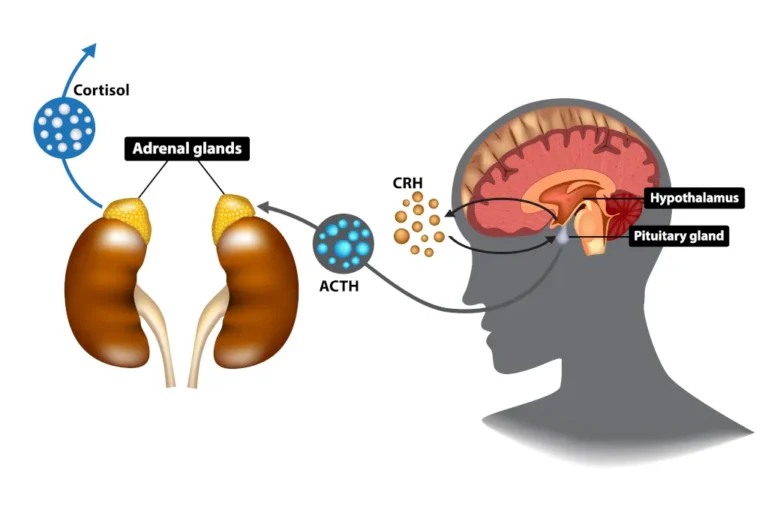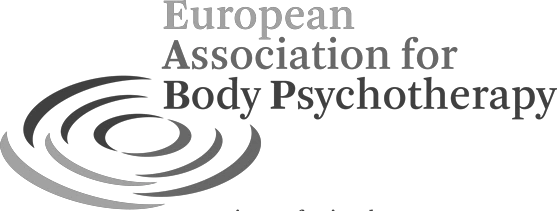Cortisol and the Stress Response
Cortisol is a natural hormone, produced by the adrenal glands. Cortisol is released with a circadian rhythm (i.e. dependent on the time of the day) with highest levels in the morning. The hormon enables dealing with stress by boosting energy. Cortisol production stimulates blood pressure, blood sugar, down-regulates the immune system and increase the overall metabolism. Therefore a regulated nervous system and appropriate cortisol level support a whole range of vital functions.
Short-term Stress Response
Upon the perception of danger a stress response is triggered: The sympathetic nervous system and associated neurotransmitters push the initial stage of the acute stress response:
- The amygdala activates the Hypothalamic-Pituitary-Adrenal (HPA) axis by signalling to the hypothalamus.
- The hypothalamus releases corticotropin-releasing hormone (CRH), which then triggers the release of adrenocorticotropic hormone (ACTH) from the anterior pituitary.
- ACTH stimulates the release of cortisol from the adrenal cortex.
- Approximately 15 minutes after the onset of stress, cortisol levels rise throughout the whole body and remain elevated for several hours.
Long-term Stress Response
Long-term stress can lead to an attenuation of the morning cortisol increase (i.e. low cortisol in the morning after waking up). Low cortisol response in the morning can lead to chronic fatique as well as bodily pain symptoms, inflammation and depression (Source, Source).
Effect of Trauma
Trauma / PTSD contributes to recurring or long-term stress and dysregulation of the nervous system, and therefore may contribute to dysregulated cortisol levels. Studies show a complex relationship of trauma to cortisol levels:
- Shock Trauma may lead to being easily triggered and experiencing flashbacks and intrusive thoughts. This may result in elevated cortisol levels due to traumatic stress being frequently triggered. Eventually it may result in lowered cortisol levels if a comorbid depression develops (see for example here and here).
- Developmental Trauma, particularly Global High Activation as a result of early childhood attachment interruptions, may lead initially to chronically high stress (i.e. elevated cortisol levels) and eventually to HPA exhaustion i.e. lowered cortisol levels.
It can be assumed that the physiological effects of HPA exhaustion as well as being stuck in a parasympathetic shutdown state will lower cortisol levels. Furthermore being stuck in sympathetic arousal states may lead to frequent spikes in stress hormones (i.e. high cortisol / stress level), which again may long term lead to lower cortisol due to HPA exhaustion.
Benefits of regulating cortisol
Insufficient cortisol regulation (too low cortisol, too high cortisol, frequent spikes in stress hormones) can have negative effects on the body and mind, including fatigue, mood disturbances and sleep disorders – all of which are common symptoms of with trauma survivors / PTSD.
- The symptoms of high cortisol level include dys-regulated stress responses, anxiety, low energy, sleep disturbances – all of which are common symptoms of with trauma survivors / PTSD symptoms.
- The symptoms of low cortisol level include fatigue, lack of focus, bodily pain symptoms, inflammation and depression – all of which are symptoms of depression, which is an important co-morbidity in more sever PTSD cases.
Regulating cortisol levels through your day can therefore directly support getting a better handle on PTSD symptoms. In addition it has a number of further benefits:
- More flexible stress response
- Cortisol helps the body to respond to and cope with stressors. It is important that stress hormones can rise up when needed (to keep up with demands of life) and get lower at other times (to get healthy relaxation including sleep). Regulating cortisol levels can help improve the body’s stress response.
- More stable Mood – Reduce stress, anxiety and depsression
- Although cortisol release is usually a response to stress, chronically high cortisol levels can themselves trigger feelings of anxiety and irritability – both are contributing to depressive symptoms. By lowering an overall high level of cortisol, a reduction in stress and anxiety symptoms can be achieved.
- On the other hand, low cortisol can cause fatigue, which also contributes to depression.
- Optimized Energy Levels – Less Fatigue & Better sleep quality
- Cortisol levels naturally fluctuate throughout the day, with higher levels in the morning and lower levels at night. We need sufficient cortisol during the day to have good energy.
- When cortisol levels are disrupted / to high in the evening due to chronic stress, it can disrupt the natural sleep cycle and lead to difficulty falling asleep and poor sleep quality (difficulty staying asleep).
- Improved immune function & health
- High cortisol levels can suppress the immune system, making individuals more susceptible to infections and illnesses. Low cortisol levels may contribute to inflammation and bodily pain. By regulating cortisol levels you contribute to overall health.
Regulating cortisol levels throughout the day can help improve stress response and sleep quality, metabolic function, and better immune system leading to better overall health and well-being.
Living Healthily – Regulating Cortisol
Reset Your Circadian Rhythm: Sunlight in the Morning
“Viewing sunlight in the morning causes ~50% increase in circulating cortisol, epinephrine and dopamine. These leverage healthy increases in energy, immune system function and mood.”
Andrew D. Huberman, Ph.D. Professor of Neurobiology at Stanford Medicine • Host of the Huberman Lab PodcastAndrew Huberman, PhD recommends viewing sunlight in the morning as a powerful way to regulate cortisol rhythms and help regulating the autonomic nervous system:
- Morning sunlight exposure establishes an early day cortisol peak – this helps you being alert during the day.
- Resetting the rhythm with morning sunlight also contributes to lower cortisol level later in the day and regulates melatonin, which is beneficial for falling asleep at night.
This is particularly important in winter, when there is insufficient sunlight and for offices works who spend a lot of time indoors. (See study here).
How to integrate in daily life:
- Morning sunlight exposure (i.e.e within 30 minutes after waking up) should be direct, not through a window or sunglasses, and should last between 2 to 10 minutes depending on the brightness (i.e. shorter on a sunny day, longer on a cloudy day.
Avoid Nicotine
Many smokers use smoking as a means to manage stress, i.e. through having a cigarette they feel that they are lowering their stress levels in the short term. Taking a smoking break with other smokers brings safety through positive social contact, which also lowers stress. However longer term physiological effects of smoking are actually the opposite. Smokers generally show elevated cortisol levels, which are assumed to be the effect of nicotine.
The effect of smoking on cortisol levels has been consistently documented in scientific studies. Smokers have higher cortisol levels than non-smokers. Smoking cessation causes lower cortisol levels. See for example the following studies here, here and here.
Avoid Caffeine
Caffeine is a stimulant which increases cortisol levels over extended time. Even one morning coffee can increase cortisol level throughout the day. Caffeine intake early in the morning it can affect the natural morning cortisol spike. With regular caffeine intake the cortisol levels remain well above base line. The effect of caffeine on elevated cortisol levels has been documented scientifically.
Benefits of Physical Exercise
Exercise is not only beneficial for physical health but also plays a crucial role in promoting mental well-being. Engagement in physical exercise is beneficial to the same physiological mechanisms, which are negatively impacted by the experience of chronic (psycho-social) stress.
One of the pathways exercise contributes to overall well-being is by modulating cortisol levels in the body: Exercise leads to a cortisol release – simply said: The more you exercise the higher the physiological release. However it has been demonstrated that the physiological stress response triggered by physical exercise has the opposite effect on psycho-social stress. I.e. the more stress hormones are released in during the exercise, the lower the stress response to a subsequent psycho-social stressor.
Physical exercise helps resetting the body’s stress system by lowering the stress response to typical psycho-social stressors
Benefits of Mindful Meditation & Movement Practices
Mindfulness practices such as meditation, mindfulness based stress reduction (MBSR) and mindful movement such as yoga and tai-chi promote relaxation, reduce muscle tension, and encourage the release of tension stored in the body, leading to a decrease in cortisol levels. It seems that this effect is most pronounced for at risk populations leading a stressful life and may be most beneficial for men (see study here)
Stress-Abbau über Achtsamkeit und Muskelaktivierung
Grounding, orienting for safety, and deep breathing are three essential practices for connecting with the present moment and reducing stress and thereby modulating cortisol.
- Grounding:
By actively grounding ourselves, sensing our feet, and flexing our knees, we establish a deep connection with the earth and the shared reality around us. This helps us stand our ground, feel supported, and move away from being lost in our thoughts. - Orienting:
To orient towards a feeling of safety involves checking if we are safe. Moving our neck allows us check for potential threats around us. It allows us to connect with the current reality, assess our safety, and effectively address the issues at hand. If there is no current threat our internal alarm system can calm down. - Deep breathing
Deep breathing, naturally deepens our breath and triggers the relaxation response. By intentionally engaging in deep breathing, we can reduce the activation of the vagus nerve, reduce nervous system activation, lower heart rate, blood pressure as well as cortisol levels.
In a further article you will learn specific mindfulness exercises, which activate muscles to reduce stress and module cortisol. Learn how to use essential techniques for stress reduction and cortisol modulation:
Breathing
Activating the natural breathing reflex
Grounding
Connecting to the shared reality
Orienting
Orienting in space (current reality) and time.










